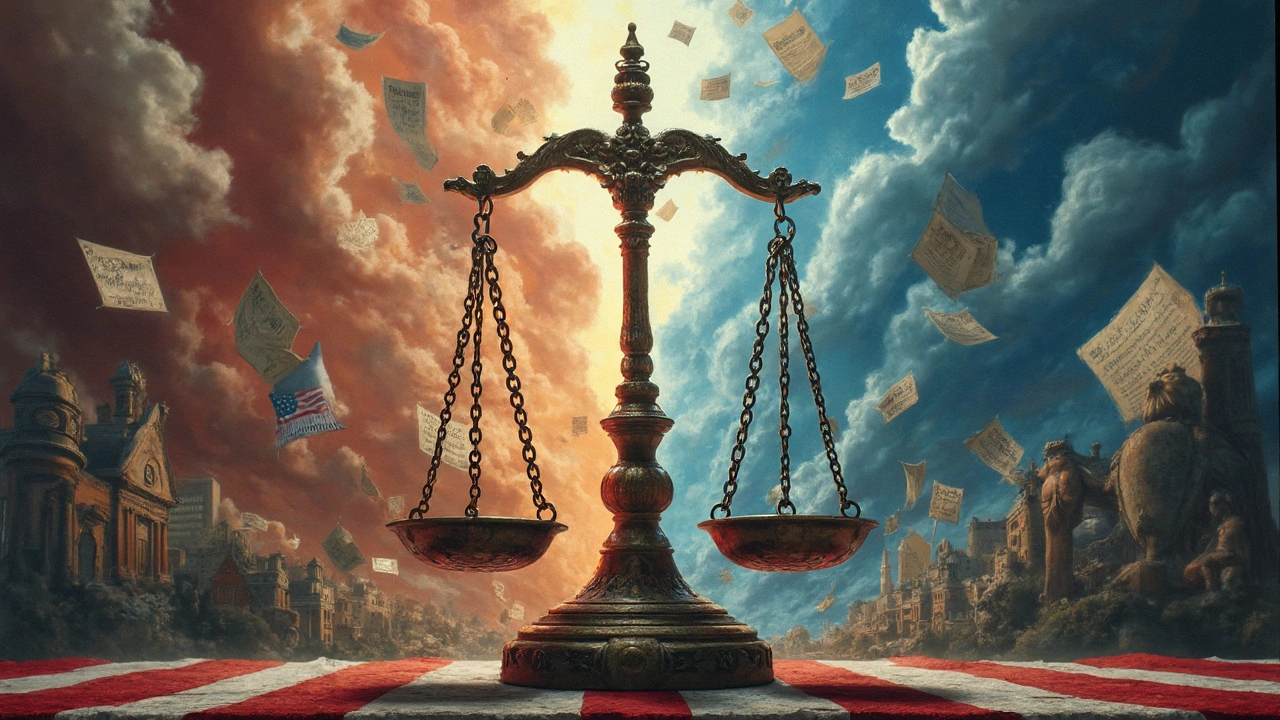
You hear a lot about the United States being conservative, but it pretty much depends on what channel you’re watching or who you’re talking to. Some states wave the Republican flag like it’s the only option. Others are more likely to hold pride parades than prayer breakfasts. If you’re looking for a straight answer, you won’t find it. The country kind of thrives on not agreeing with itself.
Let’s get real: issues like abortion, gun rights, and even what books kids can read are fueling huge fights. Just last week, one state tightened up on school policies, while another doubled down on gun restrictions. Headlines flip every day, keeping everyone guessing.
If you’re outside the US and scratching your head, you’re not alone. How does a country that just legalized gay marriage in all 50 states keep pushing for stricter abortion laws? It’s confusing, and honestly, it doesn’t fit into a neat box. But if you want to understand where the US stands politically right now, you’ve got to look past the loudest voices and check the numbers, the laws, and the real hot-button moments shaping the headlines.
- Red vs. Blue: A Divided Map
- Numbers Don’t Lie: What the Polls Say
- Culture Wars and Hot Topics
- The Supreme Court’s Role
- What This Means for the UK and Beyond
Red vs. Blue: A Divided Map
If you throw a dart at a US political map, odds are you’ll hit a state that’s either bright red (Republican) or deep blue (Democrat). The middle ground isn’t as common as you’d expect. Most people talk about the division, but it’s even clearer when you look at election results and policy differences.
Here’s a quick breakdown of how states lined up in the last US presidential election:
| State Type | # of States | Population (Estimate) |
|---|---|---|
| Red (Republican) | 25 | 136 million |
| Blue (Democrat) | 20 | 170 million |
| Purple (Swing) | 5 | 44 million |
So, you can see more states lean red, but more people actually live in blue states. Texas and Florida have big populations and usually go Republican, while California and New York tip the scale for Democrats. That’s why you sometimes get presidents who win the popular vote but lose the Electoral College, or vice versa. It really throws off outsiders trying to keep up.
Policies help split up the map too. Some states have super strict rules about abortion, some barely have any. Gun laws in California and New York look nothing like what’s going on in Alabama or Montana. Even things like minimum wage and marijuana laws switch up big-time, depending on where you are. It’s almost like you’re hopping to a different country every time you cross state lines.
If you want to see these changes up close, try searching for "state policy tracker" or check out the Pew Research Center’s handy charts. They show just how much the country divides along these lines, and it’s not changing anytime soon.
The USA isn’t red or blue as a whole. It’s a patchwork—and that’s what keeps the political fights loud and the news cycle busy.
Numbers Don’t Lie: What the Polls Say
If you really want to know where the USA sits on the conservative scale, the numbers are your best friend. Forget angry tweets or clever political ads. It's the poll data that tells you how people are actually thinking – or voting.
So, let’s look at the big picture. In a recent 2024 Gallup poll, about 36% of Americans said they’re conservative, 25% called themselves liberal, and the rest described themselves as moderate. Compare that to the year 2000, and there’s been a slight uptick in the "liberal" group, but conservatives are still hanging onto the biggest slice of the pie.
| Political ID | Percentage |
|---|---|
| Conservative | 36% |
| Moderate | 37% |
| Liberal | 25% |
But don’t think those numbers play out the same everywhere. In states like Texas and Alabama, conservatives can count on solid support—sometimes over 50% say they're right-leaning. Meanwhile, places like California or Vermont lean much more liberal. The patchwork is real.
And get this: despite all the noise about younger generations being super progressive, the last Pew survey found that about a quarter of Gen Z voters in the US actually consider themselves conservative. That’s more than you’d expect, right?
What does this mean for policies? The US is still very divided on key issues. Recent Reuters polling, for example, showed 60% of Americans want stronger background checks for guns, but less than half support a national ban on assault weapons. When it comes to abortion, recent YouGov data found 54% favor some legal access, but only around 30% support making it fully legal without restrictions.
If you’re looking to predict which way the wind’s blowing, pay attention to these polls. They’re not perfect, but they’re way more useful than political slogans. It’s the numbers, more than the noise, that reveal what’s really happening on the ground.

Culture Wars and Hot Topics
“Culture wars” isn’t just a trendy term you see on cable news. It’s what keeps Americans arguing in the streets, on Twitter, and over dinner. Topics like abortion, transgender rights, and education are all part of the mix. And each side thinks the other is way off base.
Let’s talk numbers. According to Pew Research Center’s 2024 survey, 63% of Americans say the country is more divided about social values now than at any time in the last 25 years. It’s not just about red states versus blue states—sometimes the split shows up inside families or even classrooms.
Take book bans. In 2023, the American Library Association tracked nearly 1,300 attempts to ban books in schools and libraries. The most challenged books usually tackle topics like racism and gender identity. School boards find themselves in the spotlight, often because parents show up fired up on both sides.
"These debates are not just about books; they're about who gets to decide what children learn," says Deborah Caldwell-Stone, director of the ALA’s Office for Intellectual Freedom.
If you look at abortion, the issue exploded after the Supreme Court overturned Roe v. Wade in 2022. Since then, several states moved to put outright bans into place, while others passed laws to protect or even expand access. Here’s a snappy breakdown:
| Issue | States Limiting | States Expanding |
|---|---|---|
| Abortion | 14 | 8 |
| Transgender Healthcare (minors) | 22 | 6 |
| Book Bans (attempts) | 29 | 4 |
And let’s not skip guns. Polls show about 57% of Americans want tighter gun laws, but new state laws go both ways. Texas made it easier to carry guns, while New York put in more restrictions after a mass shooting.
Hot topics don’t stay local. They spread fast on social media, with hashtags swinging public opinion in real time. If you’re following this from the UK, don’t be fooled by the loudest voices. America’s culture wars make it look like the whole country is super conservative, but it’s way more of a tug-of-war. The latest on these fights pops up on the USA news wires nearly every day, and things can shift almost overnight.
The Supreme Court’s Role
If you want to know how conservative the USA is, you can't ignore what the Supreme Court is up to. These justices pretty much decide where the line gets drawn on social issues, gun laws, and even voting rights. With a 6-3 split favoring conservative judges since 2020, their decisions have leaned hard to the right lately. This tilt isn’t just talk—it’s changing real laws and reshaping daily life for millions.
Let’s look at a few recent landmark decisions:
- Dobbs v. Jackson Women’s Health Organization (2022): Overturned Roe v. Wade, giving states the power to ban abortion. More than a dozen states put near-total bans in place almost overnight.
- New York State Rifle & Pistol Association v. Bruen (2022): Expanded gun rights by striking down New York’s restrictions on carrying firearms in public.
- 303 Creative LLC v. Elenis (2023): Ruled that some businesses can decline certain services based on free speech, even if state anti-discrimination laws say otherwise.
It’s worth noticing how these rulings often set off a domino effect nationwide. After Dobbs, for example, several states rushed to pass more aggressive abortion bans, while others put extra protections in motion. The Supreme Court isn’t just reflecting the current political scene—it’s steering it.
Here’s a quick look at just how many key rulings have split along ideological lines since 2020:
| Year | Total Major Cases | Decided 6-3 (Conservative Majority) |
|---|---|---|
| 2020 | 58 | 13 |
| 2021 | 65 | 18 |
| 2022 | 62 | 20 |
| 2023 | 63 | 21 |
So, if it feels like the country’s laws keep jerking to the right, you’re not imagining it. The court drives a lot of those changes. What they decide can shift everything from state policies to what kids are taught in schools. It’s a top-down kind of power, and right now, the top is definitely leaning conservative.

What This Means for the UK and Beyond
The way the USA swings politically always ends up having ripple effects in the UK and the rest of the world. It’s kind of wild how a decision made in Congress or by the Supreme Court can shift global conversations—on stuff like climate change, social policy, even tech regulation.
Take trade deals. When America leans conservative, UK leaders usually find the US is more interested in keeping American industries protected and less likely to make trade agreements that work for everyone. During Trump’s term, for example, the UK struggled to get far with a post-Brexit trade agreement. Biden’s administration has taken a different approach, but if US politics swings back to the right, expect those talks to stall again.
Security and foreign policy aren’t immune either. Conservative American leaders tend to push for more military spending, tighter borders, and sometimes pull back on global commitments. Look at NATO—the US under conservative leadership pressured other members (including the UK) to up their own defense spending, changing budget talks in London.
On social issues, the US Supreme Court’s moves on abortion and gun rights spark debate in the British Parliament and media. After Roe v. Wade was overturned in 2022, some UK MPs called for re-examining abortion protections at home—even though UK laws are much more liberal. Watching US states pass strict rules makes foreign leaders wonder about their own public’s attitudes.
And don’t forget tech and business. The US sets a lot of online rules—sometimes stricter, sometimes looser. Changing regulations on TikTok, cryptocurrency, and online privacy often force British companies to rethink their own strategy. British parents were especially glued to the US Supreme Court’s debate over kids’ social media use in early 2025.
The UK government seriously watches American trends, not just for headlines but for policy ideas, warning signs, and the simple fact that what happens over there can hit British wallets or change the mood on the High Street. When it comes to politics, there’s no such thing as an ocean between us.